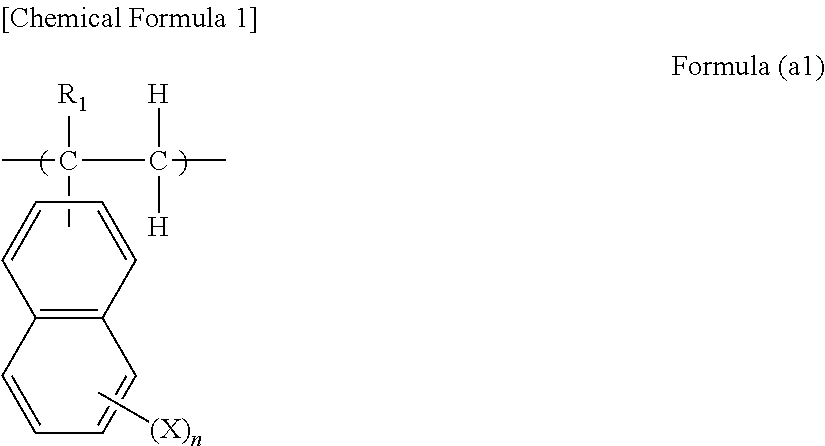Method for manufacturing semiconductor device using quadruple-layer laminate
a semiconductor and quadruple-layer technology, applied in the direction of photosensitive materials, photomechanical devices, instruments, etc., can solve the problem of difficult to apply materials for organic-based anti-reflective films on substrates having a high aspect ratio, and the influence of actinic ray reflection on semiconductor substrates has become a serious problem, so as to improve the focus depth margin of a photoresist
- Summary
- Abstract
- Description
- Claims
- Application Information
AI Technical Summary
Benefits of technology
Problems solved by technology
Method used
Image
Examples
synthesis example 1
Production of an Organic Antireflective Film (Layer C) Forming Composition
[0356]
[0357]After 6.6 g (0.039 mole) of butyrolactone methacrylate of the above formula (1), 6.6 g (0.046 mole) of hydroxypropyl methacrylate and 6.8 g (0.039 mole) of benzyl methacrylate were dissolved in 64.4 g of tetrahydrofuran, an atmosphere in the flask was replaced with nitrogen and the temperature of the mixture was raised to the reflux temperature. After starting the reflux, 0.2 g of azo-bis-isobutyronitrile (AIBN) dissolved in 10 g of tetrahydrofuran were added under nitrogen pressure, and the mixture was reacted for 24 hours. After cooling the reaction solution, the solution was poured into diethyl ether to reprecipitate a polymer, and the polymer was dried by heating to obtain the resin of a formula (2). The obtained resin had a degree of polymerization of 490 and a weight average molecular weight (Mw) of 80000 (polystyrene conversion). A ratio of x:y1:y2 was 31%:38%:31% and a yield was 90%.
[0358]
[...
synthesis example 2
Production of a Silicon-Containing Hard Mask (Layer B) Forming Composition
[0360]4.00 g of phenyltrimethoxysilane, 10.99 g of methyltriethoxysilane, 15.35 g of tetramethoxysilane, 7.08 g of water and 0.365 g of p-toluenesulfonic acid were added to 40.71 g of propylene glycol monomethyl ether. The mixture was stirred for 1 hour at 80° C. to obtain the resin of a formula (3). In the formula (3), a ratio of S1:S2:S3 is 11%:33%:56%. The obtained polysiloxane resin in the formula (3) had a weight average molecular weight of 11000 and a number average molecular weight of 3400.
[0361]
[0362]Then, 0.195 g of p-toluenesulfonic acid, 2.68 g of propylene glycol monomethyl ether, 8.78 g of propylene glycol monomethyl ether acetate and 17.5 g of cyclohexanone were added to 10 g of the reaction solution having a concentration of solid content of 39% by mass to be a 10.0% by mass solution. The solution was filtrated by using a microfilter made of polyethylene having a pore diameter of 0.2 μm to obtai...
synthesis example 3
Production of a Silicon-Containing Hard Mask (Layer B) Forming Composition
[0363]5.0 g of a polysilane compound SI-2020 (manufactured by Osaka Gas Chemicals Co., Ltd., a weight average molecule weight: 5900, number average molecule weight: 1800, a ratio of X:Y in the polysilane of a formula (4) is 50%:50%, both terminals have silanol groups) having the unit structure of the formula (4),
[0364]
5.0 g of KN 030 (manufactured by Osaka Organic Chemical Industry Ltd., a component is a copolymer of naphthol novolac and cresol novolac, and a ratio of copolymer is naphthol novolac of 70 mol % and cresol novolac of 30 mol %, and a weight average molecule weight is 1500), and 2.50 g of tetramethoxymethyl glycoluryl and 0.125 g of pyridinium-p-toluenesulfonic acid were added to 114.5 g of propylene glycol monomethyl ether acetate to be a 10.0% by mass solution. The solution was filtrated by using a microfilter made of polyethylene having a pore diameter of 0.2 μm to prepare the solution of the si...
PUM
 Login to View More
Login to View More Abstract
Description
Claims
Application Information
 Login to View More
Login to View More - R&D
- Intellectual Property
- Life Sciences
- Materials
- Tech Scout
- Unparalleled Data Quality
- Higher Quality Content
- 60% Fewer Hallucinations
Browse by: Latest US Patents, China's latest patents, Technical Efficacy Thesaurus, Application Domain, Technology Topic, Popular Technical Reports.
© 2025 PatSnap. All rights reserved.Legal|Privacy policy|Modern Slavery Act Transparency Statement|Sitemap|About US| Contact US: help@patsnap.com



